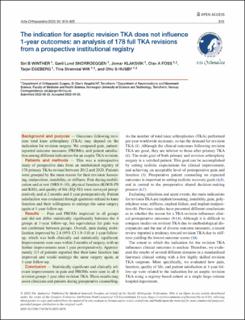| dc.contributor.author | Winther, Siri Bjørgen | |
| dc.contributor.author | Snorroeggen, Gøril Lund | |
| dc.contributor.author | Klaksvik, Jomar | |
| dc.contributor.author | Foss, Olav A. | |
| dc.contributor.author | Egeberg, Tarjei | |
| dc.contributor.author | Wik, Tina Strømdal | |
| dc.contributor.author | Husby, Otto Schnell | |
| dc.date.accessioned | 2023-01-26T14:55:06Z | |
| dc.date.available | 2023-01-26T14:55:06Z | |
| dc.date.created | 2022-11-15T14:20:06Z | |
| dc.date.issued | 2022 | |
| dc.identifier.citation | Acta Orthopaedica. 2022, 93 819-825. | en_US |
| dc.identifier.issn | 1745-3674 | |
| dc.identifier.uri | https://hdl.handle.net/11250/3046665 | |
| dc.description.abstract | Background and purpose: Outcomes following revision total knee arthroplasty (TKA) may depend on the indication for revision surgery. We compared pain, patient-reported outcome measures (PROMs), and patient satisfaction among different indications for an aseptic TKA revision.
Patients and methods: This was a retrospective study of prospective data from an institutional registry of 178 primary TKAs revised between 2012 and 2020. Patients were grouped by the main reason for their revision: loosening, malposition, instability, or stiffness. Pain during mobilization and at rest (NRS 0–10), physical function (KOOS-PS and KSS), and quality of life (EQ-5D) were surveyed preoperatively and at 2 months and 1 year postoperatively. Patient satisfaction was evaluated through questions related to knee function and their willingness to undergo the same surgery again at 1-year follow-up.
Results: Pain and PROMs improved in all groups and did not differ statistically significantly between the 4 groups at 1-year follow-up, but equivalence for pain was not confirmed between groups. Overall, pain during mobilization improved by 2.4 (95% CI 1.9–3.0) at 1-year follow-up, which was both clinically and statistically significant. Improvements were seen within 2 months of surgery, with no further improvements seen 1 year postoperatively. Approximately 2/3 of patients reported that their knee function had improved and would undergo the same surgery again, at 1-year follow-up.
Conclusion: Statistically significant and clinically relevant improvements in pain and PROMs were seen in all 4 revision groups 1 year after revision TKA. These results may assist clinicians and patients during preoperative counselling. | en_US |
| dc.language.iso | eng | en_US |
| dc.publisher | Medical Journals Sweden | en_US |
| dc.rights | Navngivelse-Ikkekommersiell 4.0 Internasjonal | * |
| dc.rights.uri | http://creativecommons.org/licenses/by-nc/4.0/deed.no | * |
| dc.title | The indication for aseptic revision TKA does not influence 1-year outcomes: an analysis of 178 full TKA revisions from a prospective institutional registry | en_US |
| dc.title.alternative | The indication for aseptic revision TKA does not influence 1-year outcomes: an analysis of 178 full TKA revisions from a prospective institutional registry | en_US |
| dc.type | Peer reviewed | en_US |
| dc.type | Journal article | en_US |
| dc.description.version | publishedVersion | en_US |
| dc.source.pagenumber | 819-825 | en_US |
| dc.source.volume | 93 | en_US |
| dc.source.journal | Acta Orthopaedica | en_US |
| dc.identifier.doi | 10.2340/17453674.2022.4878 | |
| dc.identifier.cristin | 2074351 | |
| cristin.ispublished | true | |
| cristin.fulltext | original | |
| cristin.qualitycode | 1 | |

